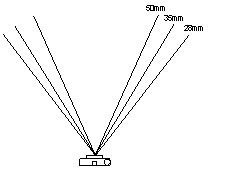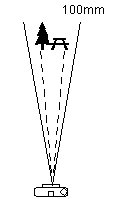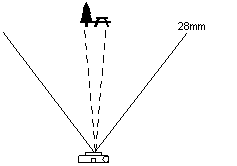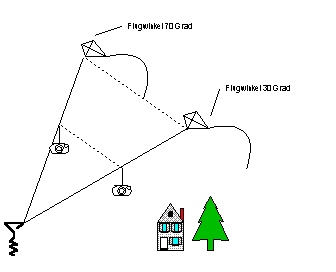
The angle of view depends on the focal distance of the object lens. A small focal distance has a large angle of view and a large focal distance has a small angle of view.

The field of view by the cameras depends on the angle of view and on the distance between camera and object. With a value for a chosen object lens you can calculate the width of the field of view depending on the distance between camera and object.
Width of view = distance * value
Focal distance (mm) 28 35 50
Angle of view (degrees) 75 63 48
Value 1,5 1,2 0,9
With the following table you can get the nescessary distance between camera and object for the chosen object size and the chosen object lens.
Focal distance (mm) 28 35 50
Person (2m) 1,30 1,70 2,20
Tree (5m) 3,30 4,20 5,60
House (10m) 6,70 8,30 11,10
Tower (20m) 13,30 16,70 22,20
It is difficult to direct an object lens with a long focal distance to an object. With every small change of camera direction the object moves a large way in the field of view. If the change of camera direction is too large, the object disappears from the field of view. With large movements on photos you get blurry pictures. On video it is difficult to follow the large change of information.

On object lenses with small focal distances the angle of view is much larger. With the same change of camera direction you have the same movement by the object. But with the larger field of view the camera always see the object. You have to do large changes on camera direction to move the object out of the field of view. On photos you will not see any affects by small changes of camera direction. Perhaps the object is a little bit out of the middle of the picture. On video the eyes compensate small movements. If you look at the edges of the screen you will see the small movements.

The flying camera system is not really stable. There is always a small movement by the flying line. Depending on the wind speed you have changes of the camera direction. For KAP it suits better to use a wide angle object lens. Even if the camera did not point directly to the object, it is possible to have the object in the view. There are less problems by changing the flying angle of the kite. If you use a objet lens with zoom select a small focal distance.
Depending on the focal distance it is difficult to set the right distance on the object lens, too. With long focal distance you have to set the distance more exactly as on short focal distance. Object lenses with small focal distance set to infinitiy distance make good photos of objects on distances of a few metre.
If the distance is set by the camera automatical, there may be problems on every small change of camera direction. It is possible to set the distance for the flying line in the field of view and not for the chosen object. If possible use the manual mode and set the distance to infinity.
Every kite react on changes of wind speed with changing the flying angle. The fix point is the anchor. The kite makes the largest change to the last flying point. A camera system on the line changes the point depending on the distance to the kite. With leaving the last point the camera station starts to swing until it is placed stable at the new point. With this move the camera changes the direction of view and the object is not stable in the field of view.

If the system is fixed very high near the kite the movement will be larger as if the system is fixed near the anchor of the flying line. It is better to have more distance between system and kite as between anchor and system. With the smaller changes of the camera system by the kite the field of view is more stable and the objekt nearly at the same place.
With changing the flying angle the distance between objekt and camera will change, too. With a low flying angle it is difficult to check the camera height and the camera direction towards the object.
I think everyone knows the main rules for security on kite flying. Here are
the main rules in a short form to remember:
In addition to the common rules here are some notes especially for kite aerial
photography:
A main point is the security about the suspended loads on the kite line. A broken kite flies slowly towards the ground, but a released camera system falls fast towards the ground. During the impact a large force is produced which can lead to a large damage.
For an example we use a weight of 1 kg. That is the weight of an usual camera station. With the height (s) and the earth acceleration (a=9.81m/s2) we calculate the speed for the impact (v=sqrt(s*a)). In a chosen time the impact speed decreases to zero. it depends on the ground on which the load falls. we will use a time of 0.1 s. On soft ground this time will be longer and produce less force.
Now we can calculate the force by impact depending on the height of releasing
the system and compare it with a corresponding weight:
Height Impact speed Impact force corr. weight Falling time 5m 7m/s 70N 7,1kg 0,7s 10m 9,9m/s 99N 10kg 1s 15m 12,1m/s 121N 12,3kg 1,2s 20m 14m/s 140N 14,3kg 1,4s 50m 22m/s 220N 22,4kg 2,3s 100m 31,3m/s 313N 31,9kg 3,2s 200m 44,3m/s 443N 45kg 4,5s
The table shows how weighty a falling camera system is. There is enough time to see the falling camera system and the impact on ground.
The time during impact is only a defined value. In the way you reduce the time for impact the force will increase and the corresponding weight, too. An impact by a falling camera system from 20m height is comparable with an car accident in town.
Aufsicht Michael Haugrund DraMa 8/91 Seite 8 Article about Kite Aerial Photography with describtion of a camera system. Hawaiian-Fotoflug DraMa ?/?? Seite ?? Kite aerial photography with stunt kites. K.A.P.W.A. Treffen 1993 Sport und Design Drachen ?/93 Seite 28 Article about first KAPWA-Meeting in Germany. Die Foto-Seilbahn Ralf Beutnagel Sport und Design Drachen 4.94 Seite 15 Article about cable car system for use on kite aerial photography. Elektronische Fernauslösung Ralf Beutnagel Sport und Design Drachen 2.95 Seite 74 Article about modification on camera Rollei Prego Xenar. Die Picavet-Fotoaufhängung Ralf Beutnagel, Wolfgang Bieck und Otto Böhnke Sport und Design Drachen 5.95 Seite 57 Article about Picavet-suspensions. the aerial eye Brooks Leffler Magazine especially for kite aerial photographer (Out of print) Kite Aerial Photography Mark Cottrell The Kite Store Ltd 1987 Information about suspensions, cameras, camera stations, control systems and useable kites. Aerial Photography by kite Raoul C. Fosset The Drachen Foundation 1994 Information about kites, cameras, camera stations and technic for photo. Aerial Photographs taken from a Kite G. de Beaufford/M. Dusariez Kapwa Foundation Publishig 1995 Book about kite aerial photography in french or english with article by Arthur Batut.
[ Index ] [ Contents ] [ Top of Page ]
©2015 Harald Prinzler